How To Build Your Remote Job Portfolio and Stand Out Online
Follow these 7 tips, best practices, and real-world examples to create a job portfolio that attracts remote jobs, wows hiring teams, and shows off your best work.

Every professional in the digital age needs an online job portfolio — and this goes double for candidates in the remote job world.
A job portfolio gives you the best opportunity to create a memorable first impression of your professional life. It also raises your clout and credibility. And it’s a fantastic way to introduce yourself to people who may never get to meet you in-person.
But if you’re like most job seekers, the thought of creating a stellar job portfolio may be too overwhelming or intimidating to tackle. So today, we’re going to help you stop procrastinating and inspire you to get started.
You’ll learn our favorite tips and best practices in this guide, plus peek at a few real-world examples to see how others in your industry are acing this task.
But before we get to those, let’s make sure we’re all on the same page first.
Getting Started: Remote Job Portfolio FAQ
You may not be able to visualize your job portfolio if you don’t actually know what it is or what it can help you accomplish. So let’s run through these frequently asked questions to get the basics under your belt:
What is a Job Portfolio or Work Portfolio, Anyway?
A work or job portfolio showcases your best professional samples, achievements, and highlights from your career. It should give someone a comprehensive understanding of your greatest skills and capabilities while showing off your unique personality and point of view.
Though physical portfolios used to be the norm, now this type of tangible evidence can live online on your website or on industry-specific portfolio sites.
Is a Job Portfolio the Same as a Personal Website?
Yes and no.
The goal of a job portfolio should be to pique the interest of hiring teams. Once they see your professional accomplishments, they should feel compelled to add you to their network or call you for an interview.
On the other hand, a personal website allows you to express yourself and share your interests outside of your professional life. It doesn’t necessarily have the same focus (i.e., expanding your network, helping you land a remote job, etc.).
But sometimes, your personal website can turn into an incredible job portfolio. Take writer Sam Woolfe for example. He started writing about his interests in philosophy, mental health, and travel on his blog.
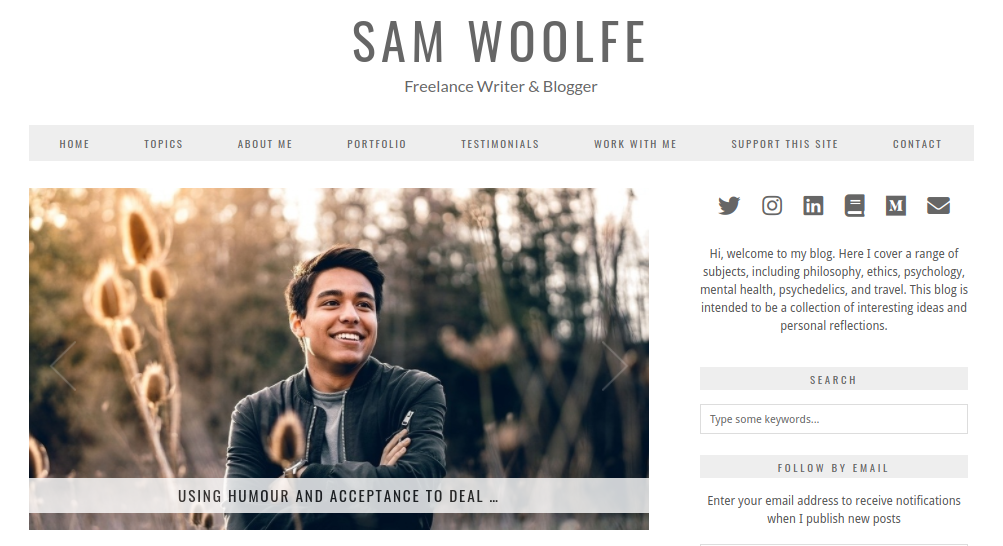
When media outlets saw these prime examples of his work, they contracted him to write pieces for their sites. This eventually helped Sam build a collection of links to his work online, which visitors can browse when they click on his portfolio.
Though the lines are blurred between personal website and job portfolio, it accomplishes the same tasks: to carve out his place in his field and encourage key decision-makers to work with him.
What Should a Job Portfolio Contain?
A portfolio provides specific examples of your work, so it will contain different materials based on your industry and career path.
The most common items added to a job portfolio include:
- Articles
- Videos
- Photos from ad campaigns
- Case studies
- Samples of code
- Artwork
- Market evaluations
- Presentations and whitepapers
- Annual/quarterly reports
- Press releases
- Graphs and surveys
- Lesson plans/training materials
- Workflows that improved processes/saved money/etc.
- What you’re currently working on
What if you’re just starting your career and don’t have any examples? No worries! You can create mock-ups that show what you would do if given the opportunity. You’ll get to show off your skills, your imagination, and that you’re a self-starter.
Do I Really Need a Job Portfolio to Land a Remote Job?
Yes! A job portfolio:
Helps you stand out from the competition. No two portfolios will ever be the same, just like remote candidates. If you’re vying for the same positions, a memorable online portfolio will give hiring managers a peek at your capabilities and personality, which may make it easier for them to envision you on their team.
Allows you to expand on your resume. There’s only so much real estate on your resume. An online portfolio expands the scope of your diverse skills and speaks to the quality of your abilities. You can write about how well you design websites in your cover letter, but seeing the tangible proof tells prospective employers, recruiters, and clients you really do know your stuff.
Boosts organic job offers and network connections. Building a keyword-rich website takes your remote job search to the next level. When hiring teams perform searches for candidates like you, they’ll come across your portfolio, reach out to connect, and may discuss fresh opportunities not advertised on remote job boards.
So now that you know why a job portfolio will help you get hired, let’s go through the 7-step process.
How to Build Your Remote Job Portfolio and Stand Out Online
Follow these seven steps to create a portfolio that helps you land remote interviews and wow potential employers:
1. Choose a Home for Your Portfolio
You have a wide variety of choices for where you want your portfolio to live online.
If you’re in a specific field, portfolio sites exist where you can display curated clippings or snippets of your work, including:
- Muck Rack (journalists)
- Clippings.me (copywriters, bloggers, and editors)
- Behance and Dribble (graphic designers)
- CodePen (front-end designers and developers)
However, most people will get more use out of a personal website.
2. Think About Your Branding and Goals
If it feels weird to market yourself, consider how you’d describe yourself to a visitor if you were a brand. What are the three biggest takeaways you’d want someone to leave with? How can these traits or abilities help a potential employer?
Sean O’Connor, a marketing strategist, created a memorable mission statement that commands attention. Then, under umbrellas like Marketing and Product, he picked three bullet points to break down how he specifically helps with brand positioning, market research, and more.
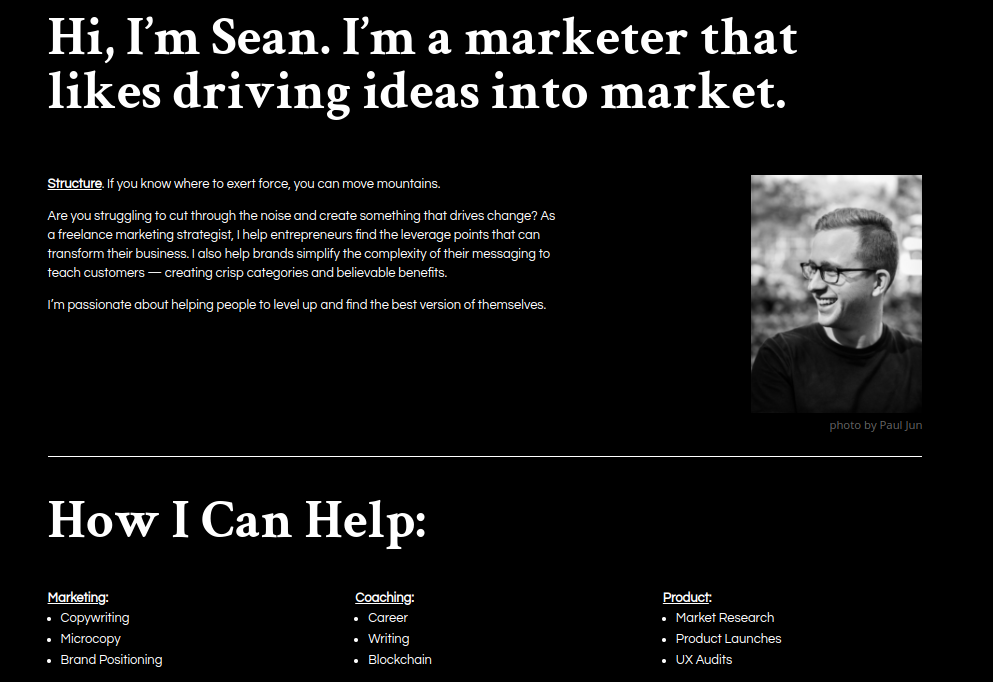
This concise wrap-up immediately introduces his skills and shows potential employers what’s in it for them. His black and white color palette also lends to his personal branding.
When you create a distinct color palette, it reflects your personality and helps you stand out. So choose a handful of colors that harmonize well and don’t distract from the pieces in your portfolio. Need a bit of inspiration? Experiment with Coolors, a free color scheme generator.
3. Map Out Your Navigation
Your online portfolio must be organized and presented in an aesthetically pleasing, user-friendly manner that encourages visitors to interact and engage. At the very least, visitors will be searching for information on these specific pages:
About Me. Here’s where you can dish about your background and tell potential employers more about your passions and experience. Stuff this page with personality, industry keywords, and all the weird things that make you special.
Resume. You can copy and paste your resume here (with the most sensitive information redacted), so visitors can scan your professional timeline and prior roles. You could include a link to download your resume as a PDF or Google Doc too.
Achievements, Notable Awards, and other professional goodies. Have accomplishments or tidbits that don’t quite fit on your resume? Use this page as your online trophy room for honors and recognitions, such as:
- Job-related certificates and licenses
- Trainings, workshops, and conferences you’ve attended
- Organizational memberships/industry associations you belong to
- Public service and community involvement
- Vocational competitions you’ve participated in
Contact. Give visitors the best way to reach out and connect with you, either by including a form that goes right to your email or by adding links to your professional social channels.

Contact form example from Eina Onting a Vancouver-based front-end developer
Work Examples. This is the meat and potatoes of your job portfolio (and we’ll dive into this next!).
While most website generators will make sure your site is optimized for desktop and mobile, it’s always smart to check that these pages look good on multiple screens. You never know where a key decision-maker may be when they stumble on your page.
4. Create a Visually-Appealing Portfolio of Your Best Work
Each piece in your portfolio should give visitors the best representation of your work and what they can expect if they hire you.
This means you’ll want to round up all your options, rank the samples you’re most proud of, and place these at the forefront. Visitors have limited attention spans, so you don’t want to hide your most impressive pieces.
Try to stick to a single page of thumbnails so visitors score a bird’s eye overview of the best pieces of your career. If visitors need a bit of context, you can add a sentence or two to describe each piece, then link to a separate landing page where you can go into greater detail and add more images.
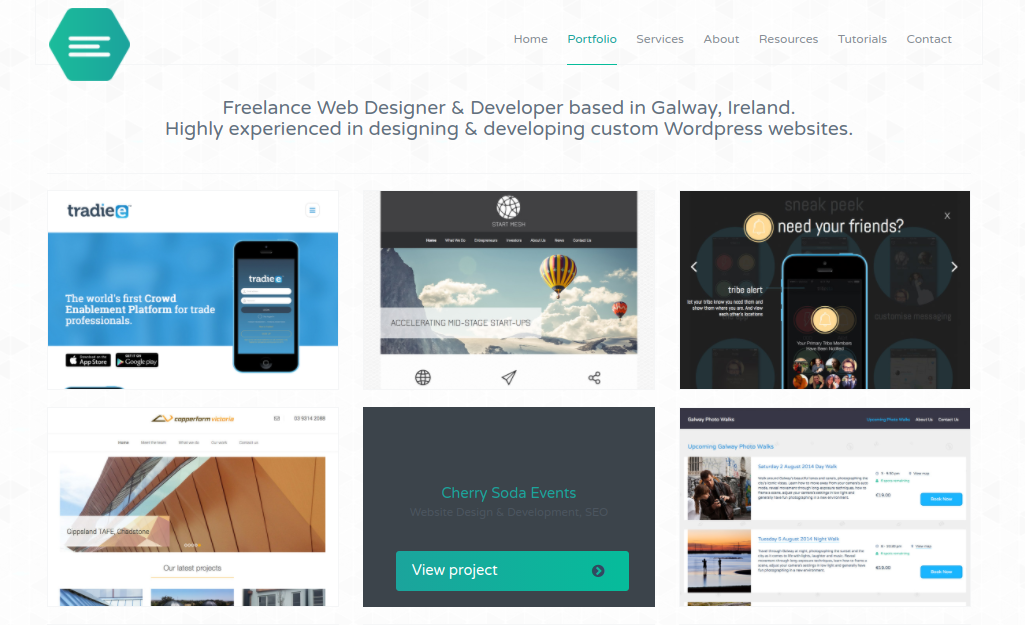
Emily Ridge, a web designer and developer, organized all her projects on a single page (pictured above). When visitors click on the thumbnail to read more about a project, they’re directed to a specific landing page with information including the client’s background, Emily’s services provided, and her core responsibilities. There’s even a link to view the website and her work in action (pictured below):
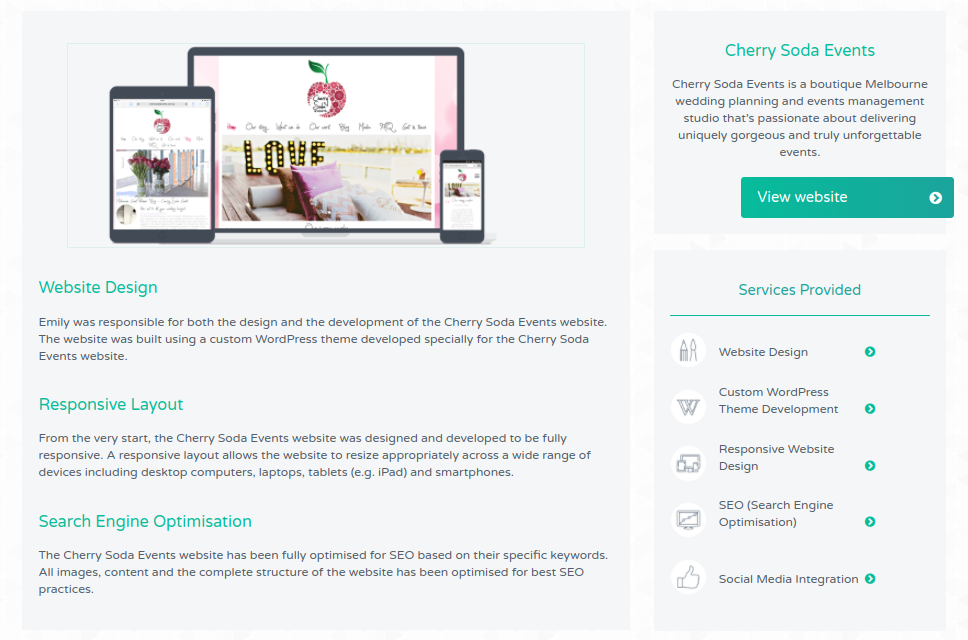
What if your portfolio pieces don’t have a visual element? If you work in network security or finance, for example, you may want to take a page out of Eina Onting’s book. This developer presents her best work by describing her client and exactly what she did to help them:
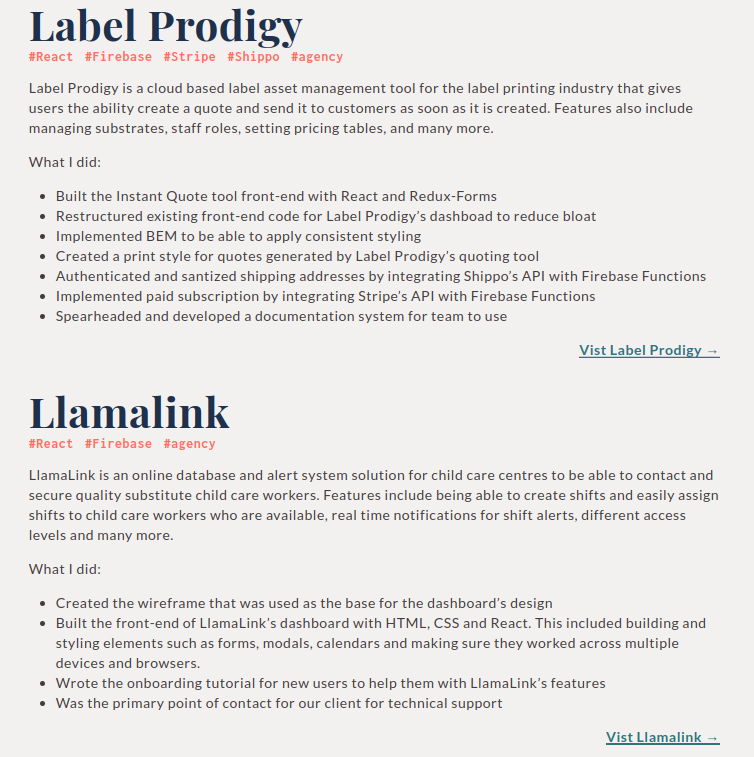
Visitors can then follow the links to see Eina’s work live.
You may want to experiment with both types of portfolio presentation styles to see which works best for your pieces. Just make sure the layout is attractive and easy to read like these two examples.
5. Include a Few Pictures of Yourself
Let visitors get to know the friendly face behind your awesome portfolio pieces by including a few photos of yourself.
When potential employers see your smile, they’ll automatically think you’re friendly, easy to work with, and worth recruiting for their team. And if you include snaps of you working or volunteering, you’ll add another layer of credibility (and prove you’re not a robot!).

Andrew Huang, a music producer who’s created branded content for Google, Netflix, Disney, Apple, and more, uses his photo op to show off his creative side (pictured above).
6. Add Some Social Proof
Unlike a review from your mom or bestie, when hiring teams see reviews and recommendations from industry leaders, they perk up and take notice.
Testimonials from clients, managers, or previous employers and teachers show why working with you is different. If you’ve worked for any big and recognizable brands, adding company logos does the same thing.

Writer and journalist Kristin Wong not only nails her personable picture and bio, but also adds a section of media logos to show off her impressive features in outlets like The New York Times (pictured above).
7. Keep Up With Your Portfolio
Your online job portfolio isn’t a one-and-done project; it’s a work in progress. It should evolve as you progress in your career. So don’t neglect it once it’s live.
Schedule a time every month to update your portfolio with new pieces and your current works in process. You should also check that your links are all working, images show up, and that your contact info is current.
Final Thoughts on Creating an Online Job Portfolio
Besides the physical process of creating a job portfolio, some people procrastinate simply because they feel uncomfortable “bragging” about their accomplishments and achievements. But remember: if you don’t do it, who will?
Potential employers and recruiters will never know how incredible you really are unless you give them the chance to evaluate your skills and previous work for themselves. An outstanding job portfolio helps you do just that.
So when your masterpiece is finished, add a link to your job portfolio on your resume, cover letter, email signature, LinkedIn profile, social media channels, and anywhere else you can get the exposure. Every time you apply for a remote job, your portfolio will get you one step closer to the interview round (and a leg up on your competition!).